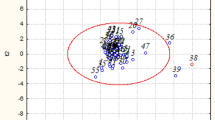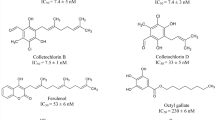Abstract
In this study, we used molecular docking and molecular dynamics (MD) simulation studies to analyze the interactions of a series of naphthalene and non-naphthalene derivatives (n = 38) as potent inhibitors of cytochrome P450 2A6 (CYP2A6) and to construct a structure-based quantitative structure activity relationship (QSAR) model. A 6000 ps MD simulation in a cubic water box were employed to build 3D structure of the CYP2A6 in a water environment. After reaching the equilibrium, the most potent inhibitor (2-bromonaphthalene) was docked into the CYP2A6 to realize the binding site of the enzyme. The docking analysis showed that π–π interaction of the inhibitors with four phenylalanine residues at positions of 107, 111, 118, and 480 plays an important role in the activities of the inhibitors. Then, an additional 6000 ps MD simulation was performed on the complex of the CYP2A6–2-bromonaphthalene to explore the effect of the inhibitor on the stability of the protein–inhibitor complex. Radius of gyration values for CYP2A6 and CYP2A6–2-bromonaphthalene complex were 2.23 ± 0.01 and 2.21 ± 0.01 nm, respectively, which revealed that the structure of the CYP2A6 in the presence of 2-bromonaphthalene has not changed. Finally, all the inhibitors docked into the enzyme and the docked configuration of the inhibitors with the lowest free energy was used to calculate the most feasible descriptors. The selected descriptors were related to the inhibitory activities using multiple linear regression (MLR) and least squares support vector regression (LS-SVR) models. The Q 2 values for MLR and LS-SVR were 0.695 and 0.728, respectively.




Similar content being viewed by others
References
Routh HB, Bhowmik KR, Parish JL, Parish LC (1998) Historical aspects of tobacco use and smoking. Clin Dermatol 16:39–544
WHO Global Burden of Disease Report 2008 Geneva
WHO Report on the Global Tobacco Epidemic, 2008
Nicotine: A Powerful Addiction. Centers for Disease Control and Prevention. (http://www.cdc.gov/tobacco/quit/canquit.htm)
Henningfield JE, Miyasato K, Jasinki DR (1985) Abuse liability and pharmacodynamic characteristics of intravenous and inhaled nicotine. J Pharmacol Exp Ther 234:1–12
Benowitz NL (1988) Drug therapy: pharmacologic aspects of cigarette smoking and nicotine addition. N Engl J Med 319:1318–1330
Zins BJ, Sandborn WJ, Mays DC, Lawson GM, McKinney JA, Tremaine WJ, Mahoney DW, Zinsmeister AR, Hurt RD, Offord KP, Lipsky JJ (1997) Pharmacokinetics of nicotine tartrate after single-dose liquid enema, oral, and intravenous administration. J Clin Pharmacol 37:426–436
McMorrow MJ, Foxx RM (1983) Nicotine’s role in smoking: an analysis of nicotine regulation. Psychol Bull 93:302–327
Russel SH (1987) Nicotine intake and its regulation by smokers. In: Martin WR, Vauhon GR, Iwamoto ET, David L (eds) Advances in behavioral biology: tobacco, smoking and nicotine. Plenum, New York, pp 25–50
Nakajima M, Yamamoto T, Nunoya K, Yokoi T, Nagashma K, Inoue K, Funae Y, Shimada N, Kamataki T, Kuroiwa Y (1996) Role of human cytochrome P4502A6 in C-oxidation of nicotine. Drug Metab Dispos 24:1212–1217
Messina ES, Tyndale RF, Sellers EM (1997) A major role for CYP2A6 in nicotine C-oxidation by human liver microsomes. J Pharmacol Exp Ther 282:1608–1614
Fernandez-Salguero P, Hoffman SM, Cholerton S, Mohrenweiser H, Raunio H, Rauto A, Pelkonen O, Huang JD, Evans WE, Idle JR, Gonzalez FJ (1995) A genetic polymorphism in coumarin 7-hydroxylation: sequence of the human CYP2A gnes and identification of variant CYP2A6 alleles. Am J Hum Genet 57:651–660
Pianezza ML, Sellers EM, Tyndale RF (1998) Nicotine metabolism defect reduces smoking. Nature 393:750
Crespi CL, Penman BW, Leakey JA, Arlotto MP, Stark A, Parkinson A, Turner T, Steimel DT, Rudo K, Davies RL, Langenbach R (1990) Human cytochrome P450IIA3: cDNA sequence, role of the enzyme in the metabolic activation of promutagens, comparison to nitrosamine activation by human cytochrome P450IIE1. Carcinogenesis 11:1293–1300
Yamazaki H, Inui Y, Yun CH, Guengerich FP, Shimada T (1992) Cytochrome P450 2E1 and 2A6 enzymes as major catalysts for metabolic activation of N-nitrosodialkylamines and tobacco related nitrosamines in human liver microsomes. Carcinogenesis 13:1789–1794
Visoni S, Meireles N, Monteiro L, Rossini A, Pinto LFR (2008) Different modes of inhibition of mouse Cyp2a5 and rat CYP2A3 by the food-derived 8-methoxypsoralen. Food Chem Toxicol 46:1190–1195
Korhonen LE, Rahnasto M, Mähönen NJ, Wittekindt C, Poso A, Juvonen RO, Raunio H (2005) Predictive three-dimensional quantitative structure–activity relationship of cytochrome P450 1A2 inhibitors. J Med Chem 48:3808–3815
Sun H, Scott DO (2010) Structure-based drug metabolism predictions for drug design. Chem Biol Drug Des 75:3–17
de Groot MJ, Ekins S (2002) Pharmacophore modeling of cytochromes P450. Adv Drug Deliv Rev 54:367–383
Poso A, Gynther J, Juvonen R (2001) A comparative molecular field analysis of cytochrome P450 2A5 and 2A6 inhibitors. J Comput Aided Mol Des 15:195–202
Wang Y, Li Y, Wang B (2007) An in silico method for screening nicotine derivatives as cytochrome P450 2A6 selective inhibitors based on kernel partial least squares. Int J Mol Sci 8:166–179
Damme SV, Bultinck P (2008) Conceptual DFT properties-based 3D QSAR: analysis of inhibitors of the nicotine metabolizing CYP2A6 enzyme. J Comput Chem 30:1749–1757
Leong MK, Chen YM, Chen HB, Chen PH (2009) Development of a new predictive model for interactions with human cytochrome P450 2A6 using pharmacophore ensemble/support vector machine (PhE/SVM) approach. Pharm Res 26:987–1000
Rahnasto M, Raunio H, Poso A, Wittekindt C, Juvonen RO (2005) Quantitative structure–activity relationship analysis of inhibitors of the nicotine metabolizing CYP2A6 enzyme. J Med Chem 48:440–449
Roy K, Roy PP (2009) Exploring QSAR and QAAR for inhibitors of cytochrome P450 2A6 and 2A5 enzymes using GFA and G/PLS techniques. Eur J Med Chem 44:1941–1951
HyperChem, Release 7.0 for windows, Hypercube, Inc., 2002
Yano JK, Hsu MH, Griffin KJ, Stout CD, Johnson EF (2005) Structures of human microsomal cytochrome P450 2A6 complexed with coumarin and methoxsalen. Nat Struct Mol Biol 12:822–823
Berendsen HJC, van der Spoel D, van Drunen R (1995) GROMACS: a message-passing parallel molecular dynamics implementation. Comput Phys Commun 91:43–56
Lindahl E, Hess B, van der Spoel D (2001) GROMACS 3.0: a package for molecular simulation and trajectory analysis. J Mol Model 7:306–317
van der Spoel D, Lindahl E, Hess B, Groenhof G, Mark AE, Berendsen HJC (2005) GROMACS: fast, flexible and free. J Comput Chem 26:1701–1719
Zhu Q, Vaughn MW (2005) Surface tension effect on transmembrane channel stability in a model membrane. J Phys Chem B 109:19474–19483
van Gunsteren WF, Billeter SR, Eising AA, Hüenberger PH, Krüger P, Mark AE, Scott WRP, Tironi IG (1996) Biomolecular simulation: the GROMOS 96 manual and user guide, Switzerland
Darden T, York D, Pedersen L (1993) Particle mesh Ewald-an NlogN method for Ewald sums in large systems J. Chem Phys 98:10089–10092
Essmann U, Perera L, Berkowitz ML, Darden T, Lee H, Pedersen LG (1995) A smooth particle mesh Ewald method. J Chem Phys 103:8577–8593
Swope WC, Andersen HC, Berens PH, Wilson KR (1982) A computer simulation method for the calculation of equilibrium constants for the formation of physical clusters of molecules: application to small water clusters. J Chem Phys 76:637–649
Kennard EH (1963) Kinetic theory of gases. McGraw-Hill, New York, p 77
Huang K (1963) Statistical mechanics. Wiley, New York
Berendsen HJC, Postma JPM, Van Gunstetren WF, Hermans J (1981) Interaction models for water in relation to protein hydration. In: Pullman B (ed) Intermolecular forces. Reidel, Dordrecht, The Netherlands, pp 331–342
Andersen HC (1980) Molecular dynamics simulations at constant pressure and/or temperature. J Chem Phys 72:2384–2393
Berendsen HJC, Postma JPM, Van Gunsteren WF, DiNola A, Haak JR (1984) Molecular dynamics with coupling to an external bath. J Chem Phys 81:3684–3690
Thompson MA (2004) ArgusLab 4.0.1. Planaria Software LLC, Seatle
Schuttelkopf AW, Van Aalten DMF (2004) PRODRG: a tool for high-throughput crystallography of protein-ligand complexes. Acta Crystallogr D Biol Crystallogr 60:1355–1363
Cortes C, Vapnik V (1995) Support vector networks. Mach Learn 20:273–297
Suykens JAK, Gestel JAK, Brabanter JD, Moor BD, Vandewalle J (2002) Least squares support vector machines. World Scientifics, Singapore
Niazi A, Sharifi S, Amjadi E (2008) Least-squares support vector machines for simultaneous voltammetric determination of lead and tin: a comparison between LS-SVM and PLS in voltammetric data. J Electroanal Chem 623:86–92
Sridhar J, Jin P, Liu J, Foroozesh M, ChLK Stevens (2010) In silico studies of polyaromatic hydrocarbon inhibitors of cytochrome P450 enzymes 1A1, 1A2, 2A6, and 2B1. Chem Res Toxicol 23:600–607
Hunter CA, Singh J, Thornton JM (1991) Pi–pi interactions: the geometry and energetics of phenylalanine–phenylalanine interactions in proteins. J Mol Biol 218:837–846
Salt DW, Ajmani S, Crichton R, Livingstone DJ (2007) An improved approximation to the estimation of the critical F values in best subset regression. J Chem Inf Model 47:143–149
Fatemi MH, Gharaghani S (2007) A novel QSAR model for prediction of apoptosis-inducing activity of 4-aryl-4-H-chromenes based on support vector machine. Bioorg Med Chem 15:7746–7754
Todeschini R, Consonni V (2000) Handbook of molecular descriptors. Wiley-VCH, Weinheim, Germany
Balaban AT (1982) Highly discriminating distance-based topological index. Chem Phys Lett 89:399–404
Bonchev D (1983) Information theoretic indices for characterization of chemical structures. RSP-Wiley, Chichester
Consonni V, Todeschini R, Pavan M (2002) Structure/response correlations and similarity/diversity analysis by GETAWAY descriptors. 1. Theory of the novel 3D molecular descriptors. J Chem Inf Comput Sci 42:682–692
Consonni V, Todeschini R, Pavan M (2002) Structure/response correlations and similarity/diversity analysis by GETAWAY descriptors. 2. Application of the novel 3D molecular descriptors to QSAR/QSPR studies. J Chem Inf Comput Sci 42:693–705
Hemmer MC, Steinhauer V, Gasteiger J (1999) Deriving the 3D structure of organic molecules from their infrared spectra. Vib Spectrosc 19:151–164
Palm K, Luthman K, Ungell AL, Strandlund G, Beigi F, Lundahl P, Artursson P (1998) Evaluation of dynamic polar molecular surface area as predictor of drug absorption: comparison with other computational and experimental predictors. J Med Chem 41:5382–5392
Winiwarter S, Bonham NM, Ax F, Hallberg A, Lennernas H, KarlCn A (1998) Correlation of human jejunal permeability (in vivo) of drugs with experimentally and theoretically derived parameters. A multivariate data analysis approach. J Med Chem 41:4939–4949
Ensafi AA, Hasanpour F, Khayamian T (2009) Simultaneous chemiluminescence determination of promazine and fluphenazine using support vector regression. Talanta 79:534–538
Tropsha A, Gramatica P, Gombar VK (2003) The importance of being earnest: validation is the absolute essential for successful application and interpretation of QSPR models. QSAR Comb Sci 22:69–77
Puzyn T, Mostrag-Szlichtyng A, Gajewicz A, Skrzyński M, Worth AP (2011) Investigating the influence of data splitting on the predictive ability of QSAR/QSPR models. Struct Chem 22:795–804
Acknowledgment
The authors are grateful for the financial support of this work from the Research Council of Isfahan University of Technology (IUT).
Author information
Authors and Affiliations
Corresponding author
Rights and permissions
About this article
Cite this article
Gharaghani, S., Khayamian, T. & Keshavarz, F. Docking, molecular dynamics simulation studies, and structure-based QSAR model on cytochrome P450 2A6 inhibitors. Struct Chem 23, 341–350 (2012). https://doi.org/10.1007/s11224-011-9874-0
Received:
Accepted:
Published:
Issue Date:
DOI: https://doi.org/10.1007/s11224-011-9874-0




